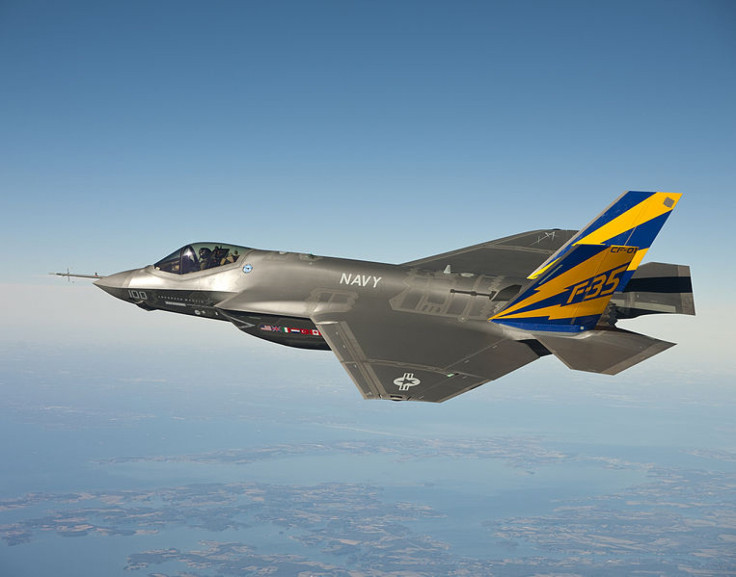F-35 Joint Strike Fighter's True Cost May Never Be Known, Amid Creative Accounting Fiascos

As the Pentagon welcomed Australia’s commitment this week to buy an additional 58 F-35 Joint Strike Fighters from Lockheed Martin Corp. (NYSE:LMT), questions linger over the astronomical costs and creative accounting presented in a recent report on the aircraft.
The Pentagon claims that after a decade of stunning cost overruns, the fighter jet is now back on track and coming in under budget, but a closer look at the data within the F-35’s annual report reveals that the figures rely upon dubious projections, including wildly speculative inflation rates and fuel and labor costs over the next 50 years.
“No one on this planet knows what inflation will be in, say, just six months time, but the Department of Defense seems to think they do,” said renowned military expert Winslow Wheeler, director of the Straus Military Reform Project, started in 2005. “The Pentagon plays this game all the time. It’s a typical example of how they manipulate long-term projections to make programs go down smoother.”
The Joint Strike fighter project has faced numerous delays and ever-rising costs since the contract was awarded to Lockheed Martin in October 2001. While the program was initially projected to cost about $200 billion, costs have risen sharply over the past eight years, to the point where the F-35 has been described as the “$1 trillion aircraft,” as current-day costs come in at about $921 billion.
Members of Congress have repeatedly criticized the inflated costs, and in 2012 lawmakers essentially reset the program’s budget and made Lockheed responsible for future cost increases. But that still leaves a hefty cost for the Pentagon, which will continue paying for its share of expenses well into the second half of this century. Yet in its 2013 F-35 report, the Pentagon claims the project has come in within budget and that costs have been reduced -- by $15.1 billion in today’s economy, or $89.5 billion, according to its 2065 projections.
However, the 97-page report doesn’t mention that the annual savings for the years 2012 to 2013 are both based on projections through 2065, the end of the program’s life. Analysts often project future costs over the short term, and often they’re wrong -- Wall Street analysts, for example, regularly miss month-to-month projections for jobs reports. Projections for the next fifty years would have to involve an unusual degree of speculation and a wide margin for error.
The costs up to 2065 -- also known as the "then year", which incorporates inflation, labor and fuel costs up to 2065 -- peg the F-35 program at around $1.4 trillion based on the 2013 project report and $1.5 billion based on the 2012 report, showing that costs based on 2065 economics have come down. Current-day costs put the overall price at $921.3 billion in 2013 and $936.6 billion in 2012. Those savings, according to the report, come from four main areas: fuel efficiency; less need for spare parts; lower inflation; and lower labor costs. But the report doesn't detail why the costs came down between the 2012 and 2013 reports.
“This is really a tricky business when you try to project costs out that far,” said Lt. Gen. Christopher Bogdan, program executive officer for the F-35 project, during a press conference last week.
However, predicting costs for the F-35 program over the next 50 years is apparently far trickier and even more detailed than taking inflation, fuel and labor costs and just stretching them out to 2065.
“This includes training for the pilots that have yet to even be born,” said Joe DellaVedova, director of public affairs for the F-35 program. “It includes every drop of fuel that will ever go in an F-35, every single part that will ever break and a replacement, the labor costs involved in those predicted breakages for the 2043 aircraft that will eventually be built and the even the chairs that those unborn pilots will sit.”
Per unit, the aircraft’s cost is expected to drop to $80 million within the next decade, according to the Pentagon. But Wheeler predicts the costs will stay nearer to $200 million for the foreseeable future, which is well below what the Pentagon projected in 2011, even suggesting at one stage that per unit cost could eventually be as high as $304.15 million. That would make Australia’s commitment to buy 58 more than its original order of 14 F-35s important for helping the Pentagon reduce projected costs. Essentially, the more partners the Department of Defense has on the project, the less direct financial support the agency has to provide.
But increasing costs and delays have made many of the military’s partners reconsider their options.
“There are several countries that are giving the F-35 the hairy eyeball,” Wheeler said. “The U.K. has already halved its planned purchase; Turkey is reducing [its order]; Italy is reducing its [previous order] and it’s about to do that again.” He even alleges the planes' cost factored into austerity discussions that fractured the Dutch coalition government in 2012, and that Canada will not stick with its commitment to buy. “And there are noises in Denmark that they want to take a step back and reconsider what airplane to buy,” he added.
© Copyright IBTimes 2024. All rights reserved.












